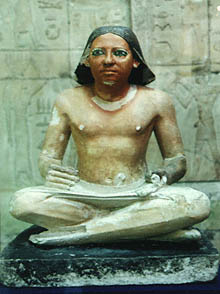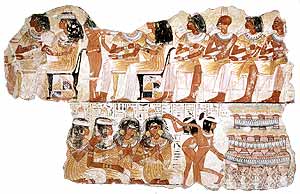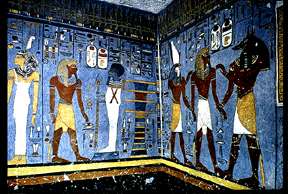
Preparing for Class:
September 20

 "The
Instruction for Little Pepi on His Way to School" (p. 32);
"The
Instruction for Little Pepi on His Way to School" (p. 32);
"Rebuke Addressed to a Dissipated Scribe" (p. 48); "Menna's Lament"
(p. 52);
"For a Portrait of the Queen" (p. 100); "The Resurrection of
King Unis" (p. 64);
"Hymn to Osiris" (p. 102); "Akhenaten's Hymn to the Sun"
(p. 1);
"Hymn to the Nile" (p. 110); and "The Leyden Hymns" (pp.
159, 160, 163, 166)
The first four
reading assignments focus on relationships within families, particularly stressing
culturally-sanctioned messages defining the concept of "a good life."
As you read, keep that concept in mind. The final five poems will introduce
you to the ancient Egyptian religion; as you read them, think about the possibility
that, as I suggested earlier, all the different Gods are actually different
ways of perceiving the same supreme being.
"The Instruction
for Little Pepi on His Way to School"
- What do you see as the
purpose of this instruction? Who is the speaker? Who is the intended listener?
How do you picture each of them as they travel along?
- What qualities are needed
if Pepi is to succeed in the career his father has mapped out for him?
- What are the advantages
of a career as a scribe?
- What other careers are
mentioned in the course of the poem? Why shouldn't Pepi pick one of them?
- At the end of stanza
xxi, the speaker reaches his conclusion: why is it better to be a scribe?
- Stanzas xxii-xxx move
on to give Pepi specific advice about his conduct as he moves into his schooling
and career. Be ready to summarize the most important qualities for a young
man who wants to succeed in his career in this culture.
- How could you update
this poem to the United States in the 21st century? Does anything the father
says sound familiar?
"Rebuke Addressed to
a Dissipated Scribe" 
- Here we have a variation
of the first reading, but in this case "Little Pepi" has apparently
messed up big time and one of his teachers is warning him that he's about
to flunk out. How do you picture the teacher? How about the student?
- Going by the physical
evidence, how is the student spending his time while he's supposed to be studying?
- In stanza 3, the speaker
makes three comparisons. What are they and how do they illustrate the problem?
- What's the prognosis
for this student? Will he make it through the semester?
"Menna's Lament"
- More bad news from Ancient
Egypt: what's Menna lamenting?
- Judging from this poem,
what is the relationship between a son and father supposed to be? How is Menna's
son, Pay-iry, breaking the rules of proper conduct?
- What are the likely consequences
of his disobedience and recklessness?
- What kinds of images
does Menna use to characterize his son's behavior?
- If the implication is
that so far Menna has been able to protect Pay-iry from the consequences of
his mistakes, why can't he do so now?
- What image of the relationship
do the following lines suggest: "You clip the wings of one who eyes your
goods, yet are you dull and dawdling in my presence."
- How might this situation
be played out in our time and culture?
 "For a Portrait of the Queen"
"For a Portrait of the Queen"
- Just as a change of pace,
we'll conclude the family poems with a tribute from a husband to his wife,
in a poem inscribed around 1300 BCE on the wall of the temple at Luxor. Who
is the speaker?
- What qualities does the
speaker value about his wife? How is she represented on the temple wall?
- This is a poem about
a queen, but what does it tell you about the ideal woman in Egypt at this
time?
- How would this ideal
woman compare with a portrait of an ideal woman circa 2003 AD?
The rest of
the poems for today deal with religious beliefs and expression in Ancient Egypt,
though they come from very different time periods. You should note the approximate
time period for each as you read.
- What is the nature of
God, as defined by the poem?
- What characterizes his
relationship with his creation? How is the physical wellbeing of the earth
related to the G
 od
being praised?
od
being praised?
- How does he feel about
humans? What responsibilities do people have to God? What responsibilities
does he have to them?
- Are there any echoes
of the Book of Genesis in the Tanakh in any of these poems?
- What do Osiris, Amon,
Re, Ptah, and Aton have in common? How are they different? One of the Leyden
Hymns even suggests that they are the same God; how can this be?
- Are there any images
that you see recurring from poem to poem?
- How does the Nile and
its characteristic behavior set up the model for the Egyptian system of belief,
as well as their social organization?
- What social values, in
particular, are seen as stemming from the rule of God?
- Overall, what conclusions
can you draw about the ways in which the various Gods are related to each
other? What is the structure of the religious universe, as perceived by the
Ancient Egyptians?
For "The Resurrection
of King Unis" you also need to look at its age in relation to the other
poems. In what ways is it similar to them? How is it different?
Return to Daily
Readings and Assignments Page
Return to Home
Page



 "The
Instruction for Little Pepi on His Way to School" (p. 32);
"The
Instruction for Little Pepi on His Way to School" (p. 32);
 "For a Portrait of the Queen"
"For a Portrait of the Queen" od
being praised?
od
being praised?